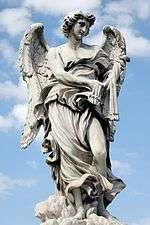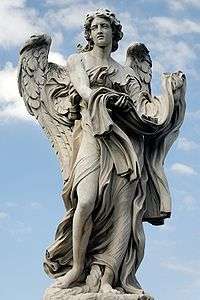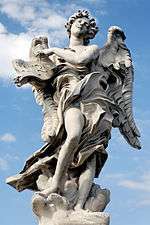Ponte Sant'Angelo
| Ponte Sant'Angelo Pons Aelius | |
|---|---|
|
Ponte Sant'Angelo, Rome | |
| Crosses | Tiber |
| Locale | Rome |
| Other name(s) | Aelius Bridge |
| Characteristics | |
| Material | Masonry |
| Total length | 135 metres (443 ft) |
| Height | 7 metres (23 ft) |
| No. of spans | 5 |
| History | |
| Designer | Gian Lorenzo Bernini |
Ponte Sant'Angelo, once the Aelian Bridge or Pons Aelius, meaning the Bridge of Hadrian, is a Roman bridge in Rome, Italy, completed in 134 AD by Roman Emperor Hadrian, to span the Tiber, from the city center to his newly constructed mausoleum, now the towering Castel Sant'Angelo. The bridge is faced with travertine marble and spans the Tiber with five arches, three of which are Roman; it was approached by means of ramp from the river. The bridge is now solely pedestrian, and provides a photogenic vista of the Castel Sant'Angelo. It links the rioni of Ponte (which was named after the bridge itself), and Borgo, to whom the bridge administratively belongs.
History
Starting with the early Middle Ages, the original name went forgotten: after the ruin of the Nero's Bridge, pilgrims were forced to use this bridge to reach St Peter's Basilica, hence it was known also with the name of "bridge of Saint Peter" (pons Sancti Petri). In the sixth century, under Pope Gregory I, both the castle and the bridge took on the name Sant'Angelo, explained by a legend that an angel appeared on the roof of the castle to announce the end of the plague. Dante writes in his Comedy that during the jubilee of 1300, due to the large number of pilgrims going and coming from Saint Peter, two separate lanes were arranged on the bridge.[1] During the 1450 jubilee, balustrades of the bridge yielded, due to the great crowds of the pilgrims, and many drowned in the river. In response, some houses at the head of the bridge as well as a Roman triumphal arch were pulled down in order to widen the route for pilgrims.
In 1535, Pope Clement VII allocated the toll income of the bridge to erecting the statues of the apostles Saint Peter (holding a book, with the pedestal inscription Rione XIV) by Lorenzetto, and Saint Paul (holding a broken sword and a book, with the pedestal inscription Borgo) by Paolo Romano to which subsequently the four evangelists and the patriarchs were added to other representing statues Adam, Noah, Abraham, and Moses. For centuries after the 16th century, the bridge was used to expose the bodies of the executed in the nearby Piazza di Ponte, at the left bridge head. In 1669 Pope Clement IX commissioned replacements for the aging stucco angels by Raffaello da Montelupo, commissioned by Paul III. Bernini's program, one of his last large projects, called for ten angels holding instruments of the Passion: he personally only finished the two originals of the Angel with the Superscription "I.N.R.I." and the Angel with the Crown of Thorns, but these were kept by Clement IX for his own pleasure. They are now in the church of Sant'Andrea delle Fratte, also in Rome.
At the end of the 19th century, due to the works for the construction of the Lungotevere, the two Roman ramps which linked the bridge with the two banks were destroyed, and on their place two arches similar to the Roman ones were built.
For the Great Jubilee in 2000, the Lungotevere on the right bank between the bridge and the castle became a pedestrian area.
List of angels
| No. | Title | Sculptor | Inscription | Image |
|---|---|---|---|---|
| 1 | Angel with the Column | Antonio Raggi | Tronus meus in columna[2] | |
| 2 | Angel with the Whips | Lazzaro Morelli | In flagella paratus sum[3] |  |
| 3 | Angel with the Crown of Thorns | Gian Lorenzo Bernini and son Paolo (original at Sant'Andrea delle Fratte, copy by Paolo Naldini) | In aerumna mea dum configitur spina[4] | |
| 4 | Angel with the Sudarium (Veronica's Veil) | Cosimo Fancelli | Respice faciem Christi tui[5] | |
| 5 | Angel with the Garment and Dice | Paolo Naldini | Super vestimentum meum miserunt sortem[6] |  |
| 6 | Angel with the Nails | Girolamo Lucenti | Aspicient ad me quem confixerunt[7] | |
| 7 | Angel with the Cross | Ercole Ferrata | Cuius principatus super humerum eius[8] | |
| 8 | Angel with the Superscription | Gian Lorenzo Bernini and son Paolo (original at Sant'Andrea delle Fratte, copy by Giulio Cartari | Regnavit a ligno deus.[9] |  |
| 9 | Angel with the Sponge | Antonio Giorgetti | Potaverunt me aceto.[10] | |
| 10 | Angel with the Lance | Domenico Guidi | Vulnerasti cor meum.[11] | |
See also
References
- Notes
- ↑ Dante, Comedy, Inferno, XVIII, 25-33
- ↑ My throne is upon a column
- ↑ I am ready for the whip. (Ps. 37:18, Sixto-Clementine Vulgate Ed.)
- ↑ [I am twisted] in my affliction, whilst the thorn is fastened upon me. (Ps. 31:4, Sixto-Clementine Vulgate Ed.)
- ↑ Look upon the face of Thy Christ.
- ↑ Upon my vesture they cast lots. (Ps. 22:18)
- ↑ They shall look upon me whom they have pierced. (Zech. 12:10)
- ↑ Whose government shall be upon His shoulder. (Isa. 9:6)
- ↑ God has reigned from the Tree. [of the Cross]
- ↑ They gave me vinegar to drink. (Ps. 68:22)
- ↑ Thou hast ravished my heart.
- Sources
- O’Connor, Colin (1993), Roman Bridges, Cambridge University Press, pp. 65f., ISBN 0-521-39326-4
External links
![]() Media related to Ponte Sant'Angelo at Wikimedia Commons
Media related to Ponte Sant'Angelo at Wikimedia Commons
- Ponte Sant'Angelo at Structurae
- The Waters of Rome: Tiber River Bridges and the Development of the Ancient City of Rome
- Ponte di Castel Sant'Angelo Virtual 360° panorama and photos.
- Satellite image
- Angels of the Passion Multimedia feature from Beliefnet.com
Coordinates: 41°54′06″N 12°27′59.25″E / 41.90167°N 12.4664583°E
%2C_Ponte_Sant%E2%80%99_Angelo_--_2013_--_4362.jpg)